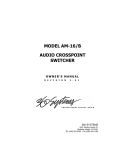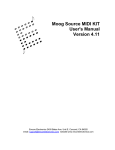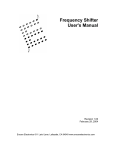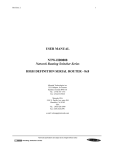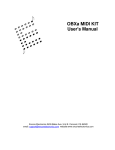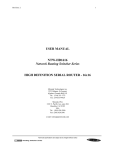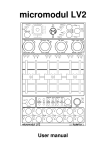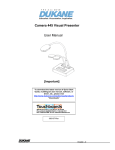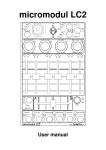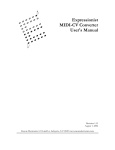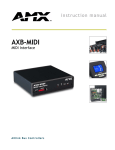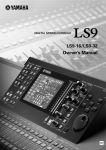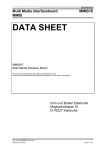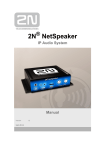Download Jupiter 8 MIDIkit User`s Manual
Transcript
Jupiter-8 MIDI KIT User's Manual ENCORE ELECTRONICS 611 LAIRD LN. LAFAYETTE, CA 94549 EMAIL: [email protected] WWW.ENCOREELECTRONICS.COM INTRODUCTION You already know that your Jupiter-8 produces unique and captivating sounds. What you may not know is that the JP8MK allows you to incorporate this quality sound into your total sound system with added flexibility and synchronicity. The MIDI KIT consists of hardware and software that, once installed, allows your Jupiter-8 to communicate with your other MIDI instruments, sequencers, and computers. This MIDI connection allows you to exchange information (such as notes, program changes or expression control) between the connected instruments and devices. This makes it possible for you to control all of your instruments from a central location, such as a computer. In addition to MIDI interfacing, the JP8MK also provides you with 64 additional patch locations that can be easily accessed. All of the new features and additions are detailed in the sections that follow. The next section of this manual is a quick reference guide which gives you step-by-step instructions for performing the new procedures. Unless specified in this manual, all other functions of the JP-8 remain the same as outlined in the original operation manual. Quick Reference Guide Keys and Controls The primary keys and controls you will use in conjunction with your JP-8 MIDI KIT are listed below. PATCH KEYS are used to select the MIDI function you wish to perform. VCA CONTROLLER is used to make parameter adjustments. How to Enter MIDI Mode o Tap the [Manual] button lightly. o The Manual LED flashes indicating that you are in MIDI mode. How to Exit MIDI Mode o Tap the [Manual] button lightly. o The Manual LED stops flashing. How to Change MIDI Channels o Make sure that you are in MIDI mode. o To change the LOWER MIDI channel (the number displayed on the left) press the [PATCH 3] button. o Move the VCA Controller until the desired channel number appears in the display (0-16, 0 being Omni on). o To change the UPPER MIDI channel (the number displayed on the right) press the [PATCH 4] button. o Move the VCA Controller until the desired number appears in the display. NOTE1: If you are in "Whole" mode, you can still edit the lower channel, but the upper channel is the only MIDI channel the JP-8 responds to. NOTE2: To adjust any MIDI parameters, or to perform a warm reset, the MEM PROTECT switch on the back panel must be in the OFF position! Quick Reference, continued How to Change Banks o Make sure you are in MIDI mode. o Press [PATCH 1] to change the JP-8 to Bank 1. o Press [PATCH 2] to change the JP-8 to Bank 2. (Patch numbers from Bank 2 are displayed with a dot between the first and second digits of the patch number). NOTE: When you exit MIDI mode, the JP-8 remains in the last bank you selected. You can only change banks from the JP-8 front panel. However, if you are selecting patches from another MIDI location, you simply press the desired patch numbered 0-127 regardless of what bank the JP-8 is in. How to Adjust Pitch Bend Scaling o Make sure you are in MIDI mode. o Press [PATCH 7]. o Move the VCA Controller until the semi-tone step value you desire appears in the display (1-12). How to Adjust Arpeggio o Make sure you are in MIDI mode. o Press [Patch 5]. o Move the VCA controller until the pulse per quarter note (ppq) value you desire appears in the display (0-24). Quick Reference, continued How to Define Breath Control Destination o Make sure you are in MIDI mode. o Press [Patch 6]. o Move the VCA controller until the correct display appears (NONE, FLTR, VCA, BOTH). How to Access Test Routines o Hold down the [Patch 1] and [Patch 3] buttons simultaneously. o Turn on the JP-8 power. o The current JP-8 software version appears in the display when the testing is completed. How to Perform a Warm Reset o Hold down the [Patch 1], [Patch 2] and [Patch 3] buttons simultaneously. o Turn on the JP-8 power. o The JP-8 returns to its default settings. NOTE: The MEM PROTECT switch on the back panel must be in the OFF position! How to Perform a Sysex Dump o Make sure you are in MIDI mode. o Press [TAPE MEMORY SAVE] o The JP-8 will dump 128 patches to the MIDI out port. WHAT'S NEW Expanded Memory Through the addition of a second memory bank, your JP-8 now contains 64 new patch locations-- a total of 128 patches in all! In order to access Bank 2 from the JP-8 front panel, you must be in MIDI mode (detailed in the next section). The JP-8 remains in Bank 2 until you manually change it back to Bank 1. This applies even if you exit MIDI mode. Patch Selection With the new expanded memory, there are two ways to select patches. If you are working from the JP-8 front panel, you can select a patch numbered 11-18, 21-28, 31-38, 41-48, 51-58, 61-68, 71-78 or 81-88 from Bank 1 or Bank 2. When you are in Bank 2, patch numbers display with a dot between digit one and digit two of the patch number. For example, patch 11 in Bank 2 displays as [1.1]. If you are working from another MIDI location, you must select your patch differently. Instead of selecting a patch numbered 11 through 88, the same patches when called from MIDI are numbered 0-127. For example, MIDI patch number 0 corresponds to JP-8 patch number 11 in Bank 1. Accordingly, MIDI patch number 127 corresponds to JP-8 patch number 88 in Bank 2. Because MIDI patch selection does not depend on banks, you do not need to change the active JP-8 memory bank before selecting a patch from the inactive bank. WHAT'S NEW, continued Patch Presets Although there are still only eight patch presets, you can now mix and match sounds from Bank 1 and Bank 2. For example, one of your preset pairs could be [11,1.1), that is patch eleven from Bank 1 and patch 11 from Bank 2. Notice that Bank 2 patches are still differentiated by a display dot between digit one and digit two of the patch number. Pitch Bend Scaling With the installation of your JP-8 MIDI KIT, you have enhanced pitch bend scaling capabilities. Instead of having to guess at the pitch bend distance, you can select a semi-tone step value from as little as one semi-tone to a full octave (1-12). You can change pitch bend scaling from either the JP-8 front panel or from your central MIDI computer location. You must be in MIDI mode before you can access this feature from the front panel. Arpeggiator Clock The arpeggiator is now capable of being clocked from MIDI. After you access the arpeggiator parameter from the JP-8 front panel, you must select the pulse per quarter note (ppq) value you desire. Values range from 1 ppq to 24 ppq. You can also select a 0 value which designates the internal (non-MIDI) clock. WHAT'S NEW, continued Breath Controller You now have the capability of using a breath controller to send MIDI messages to your JP-8. Once in the MIDI mode, you can access the breath control parameter from the front panel. After activating the parameter, you have the option of selecting your breath control destination. You have four destination choices: "NONE", "FLTR", "VCA", or "BOTH." Selecting "NONE" turns off breath control. Selecting "FLTR" sends filter sweep messages. Selecting "VCA" sends volume to VCA control messages. Selecting "BOTH" sends filter sweep and volume messages. Test Routines The JP-8 now includes test software that can indicate certain malfunctions. This check the CPU board, main DAC, and the patch memory of the new retrofit. After you complete a test, the version of software your JP-8 is using appears in the display. Warm Reset When you perform a warm reset, the JP-8 returns to its default settings. The defaults are as follows: MIDI channels to one and two, arpeggiator clock to setting 0 (internal clock), breath control destination off, and pitch bend scaling to one semi-tone. Cassette Load With the addition of more memory, the JP8 will now allow your favorite cassette patches to be loaded into the new memory simply by selecting the second memory bank and performing a normal cassette load. MIDI Dual Channel Response The JP8-MK features dual MIDI channel response. This means that you can treat your JP-8 as two separate instruments in "SPLIT" mode by setting the lower and upper timbers to different channels. There are 16 channels, 1 - 16, and 0 for Omni on. If the JP-8 is in "Whole" mode, it only responds to the upper MIDI channel. If the JP-8 is in "Dual" mode, it responds to the upper channel for all information and ignores the lower channel except for one type of message: Patch Change. This was done in order to allow modification of a "layer" without having to send note data on both channels. This simplifies the MIDI data stream and helps prevent "MIDI Choke." MIDI Messages Once you have selected your channels, the JP-8 will respond to MIDI data on the respective channels with a five octave range. The JP-8 responds to the following types of messages: NOTE ON, NOTE OFF, PROGRAM CHANGE, CONTROL CHANGE ,PITCH BEND, REAL TIME, SYSTEM COMMON and SYSTEM EXCLUSIVE The follow is a list of the MIDI controllers that the JP8-MK responds to: Control 02h 06h 07h 0Bh 40h 41h 60h 61h 62h 63h 64h 65h Function Breath controller to filter sweep and to VCA. Data entry MSB VCA for volume control Filter sweep Hold Portamento on/off Data Increment Data Decrement Non-registered parm LSB Non-registered parm MSB Registered parm LSB Registered parm MSB MIDI, continued The follow is a list of the non-registered parameters that the JP8-MK responds to: NRP Function 00 00 Arpeggio range: 1 2 3 4 00-1Fh 20-3Fh 40-5Fh 60-7Fh 00 01 Arpeggio mode: Up Down U/D Random 00-1Fh 20-3Fh 40-5Fh 60-7Fh 00 02 Assign mode: Solo Unison Poly1 Poly2 00-1Fh 20-3Fh 40-5Fh 60-7Fh 00 03 Key mode: Dual 00-1Fh Split 20-3Fh Whole40-7Fh 00 04 Panel mode: Lower Upper 00-3Fh 40-7Fh The registered parameter that the JP8-MK responds to is pitch bend sensitivity: RP 00 00 Function Pitch bend sensitivity MSB only for semitone sensitivity. COMPUTUNE is executed when the tuning button on the JP-8 front panel is pressed OR when the JP-8 receives the tune request message, F6h, from MIDI. MIDI, continued System Exclusive Commands There are many system exclusive commands supported by the JP8-MK. Each system exclusive command is listed below along with its corresponding description. o 00 - Single Patch Load F0 00 00 2F 03 00 <number> <patch data> F7 <number> Patch number to load sysex data o 01 - Request Data F0 00 00 2F 03 01 <type> <number> F7 <type> 00 to request 128 patches 01 to request a single patch 02 to request the edit buffer 03 to request the patch presets <number> 0 when type 0, 2, or 3. Patch number when type 1. NOTE: When you request all 128 patches, each patch is sent individually in ascending order. o 02 - Edit Buffer Load F0 00 00 2F 03 02 <edit buffer data> F7 o 03 - Patch Preset Load F0 00 00 2F 03 03 <preset data> F7 o 04 - Write Edit Buffer to Patch F0 00 00 2F 03 04 <number> F7 <number> The patch to which you want to save the edit buffer. MIDI, continued System Exclusive Commands, cont. o 05 - Change KEYMODE or PANELMODE F0 00 00 2F 03 05 <type> F7 <type> 00 whole 01 split 02 dual 03 upper 04 lower o 06 - Change Arpeggio Mode and Range F0 00 00 2F 03 06 <type> F7 <type> 00 1 octave 01 2 octaves 02 3 octaves 03 4 octaves 04 up 05 down 06 up and down 07 random o 07 - Assign Modes F0 00 00 2F 03 07 <type> F7 <type> 00 solo 01 unison 02 Poly 1 03 Poly 2 Installation Instructions o Save user patches. o Unplug the JP8 from the AC line and any other audio/MIDI cables. o Open the JP8. There are a total of 9 machine screws you must remove: 3 on the top edge near the keyboard, 3 on each side of the JP8 at the top edge of the aluminum side plates. o Mount the two MIDI jacks on the back panel. A suggested location is on the 1-1/4" edge of the back panel below the "an" of "Roland." You will need to drill a 5/8" hole for each MIDI jack. Be sure to check for wires, etc... behind the area you are planning to drill. Make sure to clean all loose metal before continuing on to the next step. The flanges of the MIDI jacks should go on the outside of the JP8 to cover any imperfections in the holes. Use a 5/64" (.078) drill bit for the four mounting holes. The supplied screws should thread right into the back panel. [Suggestion: Install the MIDI IN jack to the left (towards the volume control) of the MIDI OUT jack.] o Remove the 4 screws on the INTERFACE BOARD. (Not the two near the hinge.) Move the INTERFACE BOARD up out of the way to gain access to the CPU BOARD. o Remove the 3 or 4 ROMs from the CPU BOARD. Most are socketed; however, the latest JP-8s didn't have sockets. You will need to socket locations A and C. o If your JP8 does not have the DCB hardware, skip this step. If your JP8 has the DCB already installed, you must remove the wire connecting the Z80 processor NMI [pin 17], and Inverter IC10 pin10. The wire will be located on the bottom of the CPU board, and therefore the CPU board will have to be removed in order to remove this wire. If the trace between R50 and the Z80 has been cut, reconnect it. The main point here is to connect pin 17 of the CPU to the NMI wire from the JP8-MK and nothing else. o Install the JP8-MK in ROM sockets A and C. Be careful to not bend any pins. Installation Instructions, continued o Solder the 12 wires from the JP8-MK to the appropriate locations on the CPU board as show in Figure 1. The 12 numbers in Figure 1 correspond to the 12 numbers around the board in Figure 2. The order is suggested. o Neatly route the wires from the MIDI jacks along the wiring harness towards the MIDI board. o Solder the MIDI jack wires to the MIDI board as shown in Figure 2. o Locate the following parts on the INTERFACE BOARD: IC17 and IC22. IC 17-pin12 must be connected to IC 22-pin6. Locate IC17 - It is almost in the center of the interface board, below the DAC and to the right. If you view the Interface board from the bottom you will see a group of 10K resistors numbered R52 through R57. (See Figure 3) Notice two holes just above R52, one hole is connected to the left side of R52 and the other looks like it goes nowhere. (It is actually connected on the top side.) Solder the included wire to the hole on the right. Now find IC22 from the bottom side of the board. Solder the other end of this wire to the hole that is connected to pin 6 (approximately 1/4" below IC22). You can connect this wire on the top side of the interface board if you prefer. o Lower the INTERFACE BOARD back in place and secure it with the 4 previously removed screws. If the DCB was installed, you might have trouble securing the interface board. You can cut the cable that connected the interface board near the CPU board with a pair of scissors, or you can simply not attach the two center screws to the interface board. o Reinstall the nine remaining screws in the JP8 and perform the WARM RESET. Note: The MEM Protect switch must be in the OFF position for warm rest to work. o Reload the customers patches. MODEL: JP8MK Date: 7/11/91 Version: 5.10 MIDI IMPLEMENTATION CHART FUNCTION... Basic :Default Channel :Changed Default Mode Messages Altered Note Number True Voice Velocity Note On Note Off After Key's Touch Ch's Pitch Bender Control Change 2, 6, 7, 11, 64, 65, 96, 97, 98, 99,100, 101 Transmitted x x x x x x x x x x Recognized 1 1-16 x Mode 3 x x 0-127 36-96 x x x x o o Remarks :Warm Reset :Memorized Powers up in this mode. JP8MK will operate in all modes. + -1 octave, programmable in semitone intervals. 2- Routes to VCA and/or filter cutoff 6- Data Entry 11- Routes to filter cutoff 96,97- Data inc, Data dec 98,99- NRP 0: Arpeggio range 1: Arpeggio mode 2: Assign mode 3: Key mode 4: Panel mode 100,101 - Pitch bend sensitivity, semitone steps Prog Change True# System Exclusive System :Song Position :Song Select Common :Tune System :Clock Real Time:Commands Aux :Local ON/OFF Mes:All Notes Off sages :Active Sense :Reset Notes x o 0-127 o o x x x x x o x o x o x x x x x x x x Echoes all bytes to MIDI OUT port. Mode 1: OMNI ON, POLY Mode 2: OMNI ON, MONO Mode 3: OMNI OFF, POLYMode 4: OMNI OFF, MONO ENCORE ELECTRONICS See accompanying pages. Same as COMPUTUNE Clocks arpeggio with 1-24 PPQ Starts and stops arpeggio if JP8 is in ARP. mode o: YES x: NO JP8MK MIDI Specification 1991 RECOGNIZED RECEIVE DATA STATUS SECOND THIRD DESCRIPTION 1000nnnn 0kkkkkkk 0xxxxxxx Note OFF Note2 kkkkkkk = 0-127 1001nnnn 0kkkkkkk 0vvvvvvv Note ONNote1 kkkkkkk = 0-127 vvvvvvv = 0-127 1011nnnn 0ccccccc 0vvvvvvvControl Change ccccccc: control # vvvvvvv: control value 1100nnnn 0vvvvvvv 1110nnnn 0vvvvvvv0vvvvvvvPitch Bend Program Change 0vvvvvvv = 0-127 11111000 Timing Clock Note3 11111010 Start Note3 11111011 ContinueNote3 11111100 Stop *1 *2 *3 Note3 Does not respond to velocity, except for v=0 being a running status NOTE OFF. Does not respond to velocity. For arpeggiator ENCORE ELECTRONICS JP8MK MIDI Specification 1991 Controller Messages Bnh 02h 06h 07h 0Bh 40h 41h 60h 61h 62h 63h 64h 65h Description Routed to filter cutoff, VCA or both Data entry for registered/non-registered parameter editing VCA for volumecontrol Routed to filter cutoff Sustain Portamento on/off Data increment for parameter editing Data decrement for parameter editing Non-registed parameter LSB Non-registed parameter MSB Registed parameter LSB Registed parameter MSB Non-Registered Parameter # 00 00 Function Arpeggio range: 1 2 3 4 00-1Fh 20-3Fh 40-5Fh 60-7Fh 00 01 Arpeggio mode: Up 00-1Fh Down 20-3Fh U/D 40-5Fh Random 60-7Fh 00 02 Assign mode: Solo Unison Poly1 Poly2 00-1Fh 20-3Fh 40-5Fh 60-7Fh Key mode: Dual Split Whole 00-1Fh 20-3Fh 40-7Fh Panel mode: Lower Upper 00-3Fh 40-7Fh 00 03 00 04 Registered Parameter 00 00 ENCORE ELECTRONICS Function Pitch bend sensitivity, MSB only for semitone sensitivity. JP8MK MIDI Specification 1991 System Exclusive Messages F0 00 00 2F 03 000000cc <data> F7 Description Sysex header + ENCORE ID + Product # (JP8MK) cc= (See list of commands) Exclusive data End of exclusive 00 - Single Patch Load F0 00 00 2F 03 00 <number> <patch data> F7 <number> 0-7F for target patch location 01 - Request Data F0 00 00 2F 03 01 <type> <number> F7 <type> 00 to request 128 patches 01 to request a single patch 02 to request the edit buffer 03 to request the patch presets <number> 0 when type 0, 2, or 3. Patch number when type 1. NOTE: When requesting 128 patches, each patch is sent individually in ascending order. 02 - Edit Buffer Load F0 00 00 2F 03 02 <edit buffer data> F7 03 - Patch Preset Load F0 00 00 2F 03 03 <preset data> F7 04 - Write Edit Buffer to Patch F0 00 00 2F 03 04 <number> F7 <number> The patch to which you want to save the edit buffer. 05 - Change KEYMODE or PANELMODE F0 00 00 2F 03 05 <type> F7 <type> 00 whole 01 split 02 dual 03 upper 04 lower 06 - Change Arpeggio Mode and Range F0 00 00 2F 03 06 <type> F7 <type> 00 1 octave 01 2 octaves 02 3 octaves 03 4 octaves 04 up 05 down 06 up and down 07 random 07 - Assign Modes F0 00 00 2F 03 07 <type> F7 <type> 00 solo 01 unison 02 Poly 1 03 Poly 2 ENCORE ELECTRONICS JP8MK MIDI Specification 1991 System Exclusive Patch Description Each patch consists of 28 bytes. One patch will be described here. Each line will show the byte number, a description, and the value range. The JP8 does not perform range checking on parameters. Each byte is nibblized, most significant nibble first. All numbers are in hexadecimal. 00: PROTECT BYTE FOR PATCH FF=Protect, 00=Not protected 01: VCO2 RANGE 00-FF 02: VCO1 MODULATOR-LFO MOD 0D-FF 03: VCO1 MODULATOR-ENV MOD 0E-FF 04: PULSE WIDTH MODULATION 00-FF 05: CROSS MODULATION 00-FF 06: VCO2 FINE TUNE 05-FA 07: SOURCE MIX 00-FF 08: VCF CUTOFF (LPF) 00-FF 09: VCF RESONANCE 00-FF 0A: VCF ENVELOPE MODULATION 00-FF 0B: ENV-1 SUSTAIN 00-FF 0C: ENV-2 SUSTAIN 00-FF 0D: LFO RATE 00-FF 0E: DELAY TIME 00-FF 0F: HIGH PASS FILTER CUTOFF 00-FF 10: VCF LFO MODULATION 00-FF 11: VCF KEY FOLLOW 00-FF 12: VCA LEVEL 00-FF 13: ENV-1 ATTACK 00-FF 14: ENV-1 DECAY 00-FF 15: ENV-1 RELEASE 00-FF 16: ENV-2 ATTACK 00-FF 17: ENV-2 DECAY 00-FF 18: ENV-2 RELEASE 00-FF 19: D7:D6:D5:D4:D3:D2:D1:D0 :0 0 - SINE (LFO WAVEFORM) :0 1 - RAMP :1 0 - SQUARE :1 1 - RANDOM :0 0 - N/A :0 1 - VCO2 (VCO MODULATOR FREQ MOD SWITCH) :1 0 - VCO1 :1 1 - BOTH :0 0 - N/A :0 1 - ENV1 (PULSE WIDTH MODULATION SWITCH) :1 0 - MANUAL :1 1 - LFO :0 0 - 16' (VCO1 RANGE) :0 1 - 8' :1 0 - 4' :1 1 - 2' ENCORE ELECTRONICS JP8MK MIDI Specification 1991 1A: D7:D6:D5:D4:D3:D2:D1:D0 :0 0 :0 1 :1 0 :1 1 :0 0 :0 1 :1 0 :1 1 :0 0 :0 1 :1 0 :1 1 :0 0 :0 1 :1 0 :1 1 - Not used - TRIANGLE (VCO1WAVEFORM) - RAMP - PULSE - SQUARE - SINE (VCO2 WAVEFORM) - RAMP - PULSE - NOISE -0 (VCA LFO MOD SWITCH) -1 -2 -3 1B: D7:D6:D5:D4:D3:D2:D1:D0 D0 D1 D2 D3 D4 D5 D6 D7 - Not Used - VCO2 SYNC (0 = ON, 1 = OFF) - VCO2 RANGE SWITCH (0 = Low Freq, 1 = Normal) - VCF SLOPE (0 = -24db, 1 = -12db) - VCF ENVELOPE MOD SWITCH (0 = Envelope2, 1 = Envelope1) - ENV1 KEY FOLLOW (0 = ON, 1 = OFF) - ENV1 POLARITY (0 = Inverted, 1 = Normal) - ENV2 KEY FOLLOW (0 = ON, 1 = OFF) ENCORE ELECTRONICS JP8MK MIDI Specification 1991























